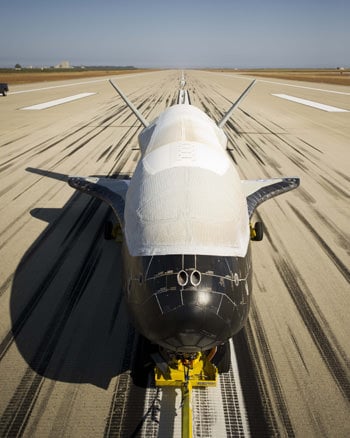Top Secret Air Force Mini Shuttle lands after Record-Setting Stay in Space
The 2nd of the US Air Force’s top secret X-37B unmanned, reusable mini shuttles safely landed on Saturday, June 16, at 5:48 a.m. Pacific local time at Vandenberg Air Force Base, California to conclude a record setting classified 469 day experimental test flight in Earth orbit.
This was the first flight of OTV-2 and the second flight of the military’s classified X-37B Orbital Test Vehicle (OTV) test program for the U.S. Air Force Rapid Capabilities Office.
The reusable space plane is designed to be launched like a satellite and land on a runway like an airplane and NASA space shuttle. The X-37B is the newest and most advanced reentry spacecraft.
OTV-2 was launched atop a United Launch Alliance Atlas V booster from Cape Canaveral Air Force Station, Fla., on March 5, 2011.
About 18 minutes after launch, the Air Force imposed a news blackout on the classified mission. Details about the cargo and experiments loaded aboard the Air Force orbital space plane are shrouded behind a veil of military security.
It is not known if the X-37B conducted reconnaissance activities during the test flight. It does have the capability to deploy satellites in space
The Air Force says the primary mission goal was to check out the vehicles capabilities and testing the ability to send experiment to space and return them safely.
>
>
The 2nd of the US Air Force’s top secret X-37B unmanned, reusable mini shuttles safely landed on Saturday, June 16, at 5:48 a.m. Pacific local time at Vandenberg Air Force Base, California to conclude a record setting classified 469 day experimental test flight in Earth orbit.
This was the first flight of OTV-2 and the second flight of the military’s classified X-37B Orbital Test Vehicle (OTV) test program for the U.S. Air Force Rapid Capabilities Office.
The reusable space plane is designed to be launched like a satellite and land on a runway like an airplane and NASA space shuttle. The X-37B is the newest and most advanced reentry spacecraft.
OTV-2 was launched atop a United Launch Alliance Atlas V booster from Cape Canaveral Air Force Station, Fla., on March 5, 2011.
About 18 minutes after launch, the Air Force imposed a news blackout on the classified mission. Details about the cargo and experiments loaded aboard the Air Force orbital space plane are shrouded behind a veil of military security.
It is not known if the X-37B conducted reconnaissance activities during the test flight. It does have the capability to deploy satellites in space
The Air Force says the primary mission goal was to check out the vehicles capabilities and testing the ability to send experiment to space and return them safely.
>
>



